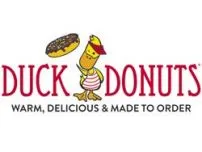Summary
U.S. donut/coffee shops live on daily, low-ticket, high-frequency traffic. Average retail rent sits near $25/sf/yr (CBRE), labor for counter/bakery staff is about $14–16/hr, and power can be 9–30¢/kWh depending on the state. Because donuts need frying, glazing and holding, you also add oil, sugar and packaging to COGS — so upsells (coffee, breakfast, drinks) are what protect margin.
Donut franchises are basically breakfast QSRs that never stopped being fun. The product is simple, recognizable in every U.S. market, and works for multiple occasions — morning coffee run, office dozen, weekend family stop, seasonal/holiday boxes. Because the core offer is standardized (raised, cake, filled, iced, limited-time flavors), franchisors can teach production quickly and keep quality consistent across locations. For first-time buyers, a donut shop franchise is attractive because the build-out is smaller than a full restaurant, the labor profile is simpler, and the brand usually gives recipes, mix/supply sources, and morning-bake routines. For multi-unit operators, donuts pair nicely with coffee or bagel concepts and can be rolled out in inline or drive-thru formats across a metro.
What actually drives donut unit economics
- Rent. National retail reports (CBRE and similar) keep showing the U.S. asking rents around the mid-$20s/sf/year. But the places where donuts really win — busy commuter corridors, school routes, corner end-caps with drive-thru, gas/retail co-locations — often rent at $40–70+/sf/yr. Since most donut shops are 900–1,200 sq ft inline or 1,000–1,400 sq ft with drive-thru, rent becomes a visible fixed line fast.
- Labor, but early. Donuts are a morning business. That means production starts early (sometimes 3–5 a.m.), and you pay people for unpopular shifts. BLS puts counter/food workers roughly in the $14–16/hr band in many states; West Coast, Northeast and high-min-wage cities will be higher. If the brand runs on-site frying instead of commissary, add at least one higher-skilled morning baker.
- Energy. Donut shops actually use more energy than people think: fryers, proofers, refrigeration, holding/warming, plus HVAC for customer areas. Commercial power in the U.S. can be under 12¢/kWh in low-cost states and 20–30+¢/kWh in California, New England and Hawaii. If you’re putting a full fry line into a high-tariff state, you write that in the P&L.
- Ingredients. Donuts sit on flour, sugar, fats/oils, eggs and dairy. Most of those have shown steady upward movement year over year. The way donut brands protect margin is not by making the donut cheaper — it’s by selling drinks, coffee, breakfast sandwiches, and by raising price on limited/seasonal SKUs where customers are less price-sensitive.
- Sales tax and local rules. Prepared food is generally taxed at the local combined rate; in some cities that’s 8–10% on every box. Also, several cities/counties have packaging and waste rules — not a big line item, but worth noting in franchise content.
- Drive-thru and speed. Donuts + coffee through a drive-thru window in the morning is still one of the best traffic models in U.S. food. Site plan (queue length) and ingress/egress can matter more than interior décor.
- Delivery/apps. Donuts are not primarily a delivery product, but bulk office orders and weekend boxes do come from delivery apps. Standard marketplace commissions (15/25/30% on delivery; ~6% pickup) mean you should treat delivery as a supportive, not core, channel.
Investment and Fees
| Format / Model | Initial investment (range) | Franchise fee (range) | Ongoing fees (royalty / ad fund) |
|---|---|---|---|
| Inline donut/coffee (no drive-thru) | $200,000 – $450,000 | $20,000 – $40,000 | 4–6% / 1–3% |
| Drive-thru donut shop | $350,000 – $900,000 | $25,000 – $45,000 | 4–6% / 1–3% |
| Kiosk / mall / transit | $120,000 – $250,000 | $15,000 – $30,000 | 4–6% / 0–2% |
| Production-heavy / café hybrid | $400,000 – $1,000,000+ | $25,000 – $50,000 | 4–6% / 2–4% |
These ranges assume a normal TI/build-out, a commercial fry line (or approved donut-making equipment), refrigeration, POS/loyalty, signage, opening inventory and working capital. If the unit needs extensive venting or is a ground-up drive-thru, capex goes to the higher end.
Cost overlay (to explain “why so wide”):
| Cost driver | Suburban / second-gen inline | Coastal / high-traffic / drive-thru |
|---|---|---|
| Rent | $20–28/sf/yr | $40–70+/sf/yr |
| Power | 9–12¢/kWh | 20–30+¢/kWh |
| Crew / bakery | $14–16/hr | $17–20/hr |
| Sales tax on prepared food | 5–7% | 7–10% |
| Delivery/app fees | 15–30% | 15–30% |
The same donut shop doing $30–40k/month can be fine in column 1 and very tight in column 2 — not because sales changed, but because rent, power and labor did.
Startup costs and ongoing fees
Startup typically includes: leasehold improvements, floor/drain changes for kitchen, fryers/proofers, refrigeration, display cases, espresso/coffee equipment, POS, smallwares, signage, opening inventory (flour, mixes, oils, fillings, cups, boxes), training, and working capital.
Ongoing spend will include:
- royalty and brand marketing;
- labor for production (early) and service (morning rush);
- ingredients (flour, sugar, oil, dairy, fillings, toppings, packaging);
- coffee and beverage supplies (beans, milk, alt-milk, syrups);
- occupancy (rent + CAM + insurance);
- utilities (especially where power is ≥20¢/kWh);
- delivery/app commissions.
Because donuts have a lower average check than, say, burgers, two things protect the P&L: coffee attachment (add a drink to every purchase) and boxes/dozens (one order, higher ticket, similar labor).
Popular donut franchise formats
Inline donut & coffee. Ideal for neighborhoods and strip centers, lower capex, strong for a.m. traffic, easy to staff.
Drive-thru donut. Highest convenience, best morning capture. Needs a bigger ticket or strong beverage line to pay for the real estate.
Kiosk / cart. Works in malls, transit, airports, large offices. Lower rent, more impulse, but limited menu.
Hybrid bakery café. Donuts plus pastries, sandwiches, soups, maybe ice cream — made to build ticket throughout the day, not only in the morning.
Each format should be priced against the local rent and labor reality — especially in California, New York, Washington and Florida, where both are above the national average.
Requirements & ideal franchisee profile
Franchisors usually want enough liquid capital to cover build-out and several months of working capital, plus the ability to run strict opening routines (donuts don’t forgive being late). Good candidates are organized, comfortable with early-morning or split-shift staffing, and ready to manage freshness — selling today’s product today, not tomorrow. Multi-unit candidates should plan for a traveling baker/trainer or a light commissary model to stabilize quality across stores.
Compliance and local checks
- Health/sanitation: most states work off their version of the FDA Food Code, so be ready for inspections on temps, handwashing, and cleaning schedules.
- Hiring: I-9 everywhere; some states require E-Verify for private employers.
- Waste/packaging: several cities ban foam or require compostable items — check locally if you sell high volumes of drinkware and boxes.
How to choose a donut franchise
- Location logic: can morning traffic actually get in and out?
- Format: inline vs drive-thru vs kiosk.
- Menu depth: donuts only, or donuts + coffee + breakfast?
- Supply: does the brand have approved mixes/vendors to stabilize COGS?
- Ticket strategy: are there boxes, seasonal, and drinks to lift AOV?
- Scalability: can you open 2–3 stores in the same city without cannibalizing?
Franchise FAQ
What is the initial franchise fee?
The initial franchise fee depends on the brand and market, usually from $15,000 to $50,000.
Do you help with international expansion?
Yes, TopFranchise works with brands that are ready to expand to new countries and regions.
How can I contact the franchisor?
You can fill in the request form on the franchise page, and the brand representative will contact you.













